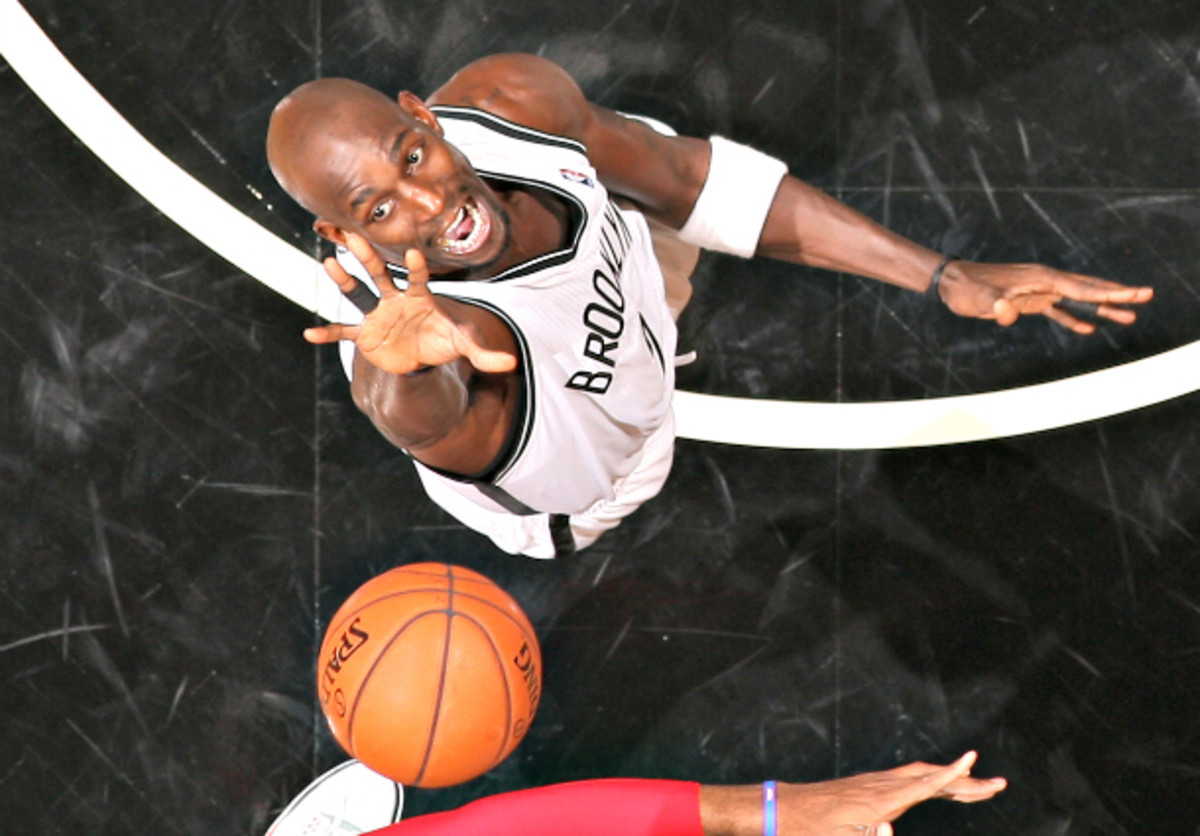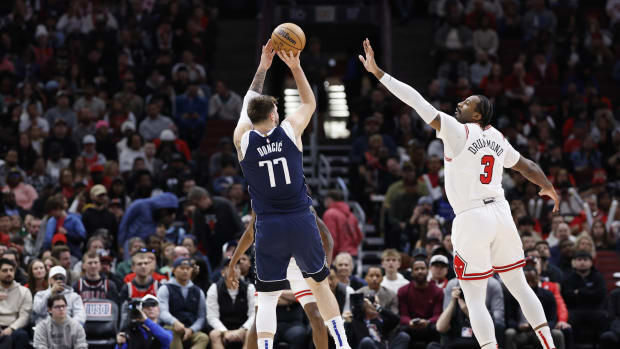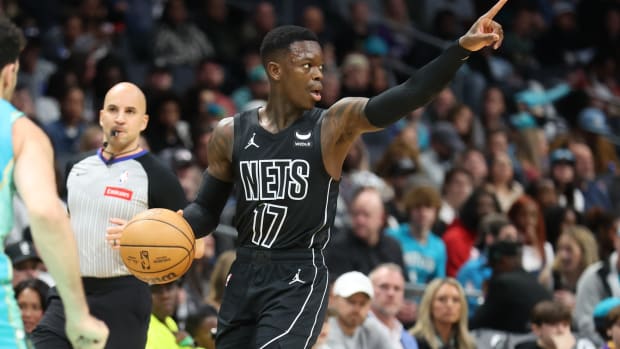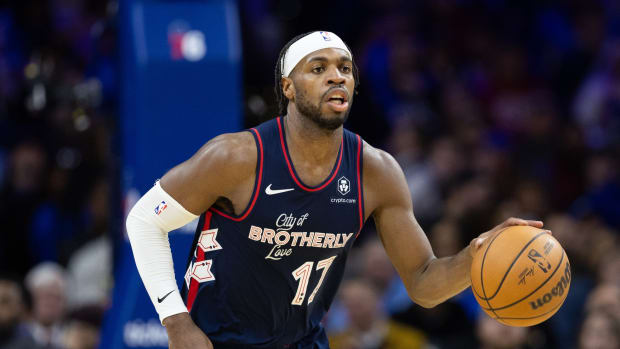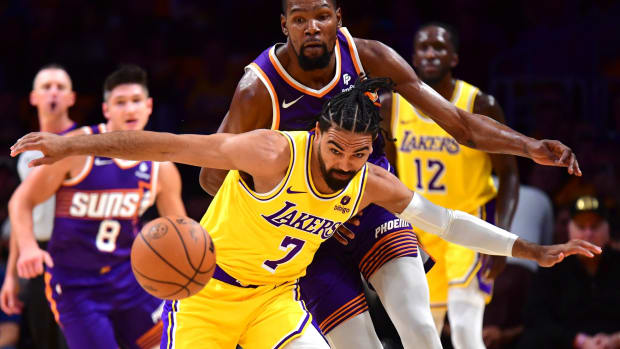The Fundamentals: Desperation tolls for the new-look Nets as troubles mount
After a 3-10 start, Kevin Garnett and the Nets are already left reaching. (Nathaniel S. Butler/NBAE via Getty Images)
At this point in the NBA season, the Nets are noteworthy in only two regards: Their still-preposterous $102 million payroll and the degree to which they've completely failed to meet every expectation. Promise has quickly faded to panic in Brooklyn, and for good reason. With thirteen games behind them, the Nets have already established themselves as one of the five worst teams in the league by way of pace-adjusted point differential -- a sound indicator of overall performance. There's some consolation, I suppose, in the fact that Brooklyn's star-cross'd rivals in Manhattan share their standing in squalor, but this 3-10 start is about as inauspicious as possible for a team with so much talent.
There's time to rectify that, though for the moment the Nets lack for even the faintest silver lining. Concerns over Brooklyn's team defense have proven prescient so far, for reasons both expected and unforeseen. The offense, too, has been a rather spectacular failure -- stale and slow to the point of ranking 24th in the league in points per possession. Some assembly was to be required upon the arrivals of Kevin Garnett, Paul Pierce, Andrei Kirilenko and Jason Terry in Brooklyn, but that kind of scoring return is rather abominable given the caliber of players involved.
Naturally, there are asterisks on the Nets' scoring bankruptcy. Brook Lopez, the team's most potent scorer, has now missed five games with an ankle injury. Deron Williams played poorly for the Nets when in the lineup, and otherwise has been dealing with his own ankle issues. Andrei Kirilenko has ailed through 53 total minutes for Brooklyn thus far, further depriving the team of his versatility. Those are three huge vacancies in the Nets' rotation that were bound to have consequences, though it's the degree to which the rest of the lineup has suffered that makes Brooklyn's trials startling still.
After all, even the Nets' complete starting lineup has been a net negative for the season, seemingly lacking in the ability to capitalize on the promise of a balanced roster. The failings of their execution begin almost immediately, as the early stages of the Nets' offense tend to progress too slowly and too sloppily to set up any kind of productive action. They're clearly running plays, just not particularly well. The ball handler often stands in place at the top of the floor while gesturing to his out-of-position teammates, dribbling seconds off the clock simply for the opportunity to begin a scripted set. This is a team clearing its throat to the point of gagging; there are so many hiccups in the expected cuts and screens that Brooklyn begins each possession from a point of disadvantage.
The problem, too, with having so many options on the floor at once is that they demand time to fully activate. One play action begets another, which sets up a counter and a smart kick-out and a wide-open look. The ability to make play after play stresses the hell out of opposing defenses and strains their ability to rotate on time, though the entire process has to begin early or else the extra pass bumps up against the shot clock buzzer. By stumbling into its offense a few seconds later than anticipated (some of which results from Livingston running the show rather than a fully healthy Williams), the Nets become a team of fewer options that's made that much easier to defend. Were the NBA played on a 35-second shot clock, Brooklyn would be a better offensive team.
Things are even worse when the Nets attempt to work off the cuff, as even the slightest delay accentuates the lack of coordination in the offense. Watch, here, as one of the Nets' more successful lineups goes about improvising off a high screen-and-roll:
The eventual shot created -- a contested corner three for Alan Anderson -- is one typical of Brooklyn's season: makeable but errant. Anderson was rushed by both Josh Smith's closeout and that oppressive shot clock, which sounded just after his wild shot caromed off the side of the backboard. If he had a bit more time, the vaguely open Anderson could have swung the ball up to the even more open Joe Johnson, who sat unattended on the wing. Then again: It's Alan Anderson, so probably not.
But the fact that Anderson can't even hypothetically consider such a pass is a problem in itself, as is the fact that the Nets are working into contested looks while whiffing on some of their more open shots. Opponents have been more than willing to let Garnett and Andray Blatche fire away on pick-and-pop jumpers, for example, knowing full well that those shots won't beat them. The results would seem to corroborate that stance, though Garnett has thankfully begun to rediscover his mid-range touch after missing so many early shots from his trademark range. That will help, but the team's inability to create and convert interior looks without Lopez is only reinforced by their persistent pick-and-pop play.
That Lopez isn't expected to miss considerable time would suggest that particular issue could be remedied, as could other offense quirks given the value of such a potent low-post threat. The central flaw in that logic: Brooklyn's already bad offense has been even worse this season with Lopez on the floor, in part because the Nets have done such a poor job of working against double teams. For his part, Lopez has scored efficiently (57.4 percent from the field!) and tried to kick the ball out when necessary. But Lopez has never been a particularly proficient passer, and is done no favors by his team's work-in-progress spacing. He's thus far managed to avoid picking up turnovers on those doubles, but the Nets on the whole haven't recovered from them quickly enough (due to slightly errant kick-outs, a lack of familiarity, etc.) to truly take advantage. What results is too often a lunge into semi-open space, followed by a rushed shot attempt of some kind.
More generally, the Nets still haven't been able to set up Lopez as consistently as they should, nor have they used any of their core players to particularly promising effect. Unlike so many other struggling offenses, the issue isn't ball movement; Brooklyn passes plenty, though in many cases swings the ball from one log-jammed action to another. The greater culprit is clumsy execution, which has seemingly deprived the offense of any momentum as it moves from one action to the next. The initial screen will be in the wrong place or at a bad angle, causing a slight delay and giving the defense a chance to recover. A corresponding off-ball pick won't arrive in time, thus causing a slight lag in another player's cut. There are minor errors all over the place -- not so severe as to blow up a play entirely, but so imprecise as to do real damage in volume.
When even a few actions can be put together in sequence -- like, say, a pin-down screen for Pierce followed by a quick curl into the lane -- a quality look often results:
Yet for all of Brooklyn's offensive talent, these stutters come far too often. Blame Jason Kidd, if you will (and as Paul Pierce essentially did), for the fact that his team runs set plays so poorly at times that they don't even appear to be set plays. Blame the veteran leaders of this roster, too, for both their individual limitations and the malaise in the Nets' execution. Fingers will be pointed and blame assigned -- of that I have no doubt. Yet more important than who's at fault is the on-court product of a supposed contender, which to date has been rather dreadful on the side of the ball that was supposed to come easy.
That things have been even worse on defense poses an entirely different problem. In all, Brooklyn has been this season's worst defensive team -- besting the Bucks, Knicks, and Jazz for the honor. This is where Lopez's absence, fascinatingly enough, has mattered most; the lumbering seven-footer has been one of the Nets' few plus-defenders this season, as his ability to clog up the interior and challenge shots has made him more defensively useful than any other Brooklyn big. Kevin Garnett, on the other hand, looks to be a man without answers. He was acquired in part to give the Nets some defensive backbone, but at the moment opponents have no reason to fear him. His rim protection has been a beat late and flimsy, oddly so even compared to his play last season. His ability to step out to defend the pick-and-roll, too, appears compromised, not only by declining speed but also weird errors in judgment:
It doesn't aid matters that Garnett gets so little help in coverage from Blatche and Reggie Evans, neither of whom can be counted on to consistently step over to maintain the back end of a conventional pick-and-roll defense. Watch on this sequence as Blatche hangs out of the play entirely after Garnett steps to the perimeter in an attempt to defend a ball screen:
Some fault lies, too, with Livingston, who tried to defend Charlotte's Ramon Sessions on this play as if Garnett were walling off the baseline. Yet those compounding mistakes are par for the course with these Nets, who never seem to be where they should and are so consistently outdone by basic actions. Watch how easily Detroit's Brandon Jennings gets by Blatche on this sequence:
Or how slow Blatche is to step up against Charlotte's Kemba Walker here:
We could run Blatche defensive lowlights all day, as he's still quite absent-minded on defense despite his marginal improvement. He's also been a legitimately helpful offensive piece for the Nets through these tough times -- often essential with Kirilenko and Lopez both out and Garnett logging just 23 minutes a night. A healthy Kirilenko should be a difference-maker upon his return, as might Lopez if his early-season precedent holds up. At a glance, though, it's hard to see how either would move the needle enough to fully make up for a noticeably lesser Garnett, Blatche doing as Blatche does, the slow-footed help of Reggie Evans and the inexperience of Mason Plumlee.
To date, the Nets suffer all of the fallout associated with playing a step slow on defense. They pick up a ton of fouls, sending their opponents to the free throw line more often than all but four other teams. They play conservatively and don't force turnovers, meaning that most every possession ends in an attempt and possible score. Their effort on the defensive glass is also woefully incomplete, as boxing out seems to be taken as more suggestion than rule.
Yet nowhere is their sluggishness more apparent than in transition, where Brooklyn opponents manage to get the jump on the Nets far too easily. For the season, the Nets have allowed roughly the same number of fast break points per game as the frenetic Timberwolves, despite ranking 22nd in pace to Minnesota's 2nd. That's pretty amazing, really, and a composite result of a variety of limitations. The lack of speed across the roster in general plays a factor, as does the age of many of the Nets' contributors and an array of minor injuries. In addition, Brooklyn has the pleasure of ranking in the bottom third of the league in field goal percentage and offensive rebounding rate -- a combination that allows opponents to leak out on the break without fear of being exploited on the offensive glass. The offensive disarray has also made floor balance a consistent problem, as too many Nets players are straying below the break and out of range to help in transition.
On top of it all: Opponents have had no problem streaking by Johnson, Garnett, and Pierce when given the opportunity to work up a head of steam, making it all the more difficult for the Nets to defend even when they do get back in time:
All it takes is a single step. Once an opposing ball handler gets even the slightest advantage on a Brooklyn defender, the possession may as well be over. The help, the discipline, the positioning, the effort -- none of it is where it needs to be, and the Nets' defense is suffering for it. Opponents already understand that they can run the ball down Brooklyn's throats, and it's no coincidence that the Nets' two biggest losses of the season came to two of their fastest-paced opponents (Minnesota and Orlando). That wouldn't be a fatal flaw were it not for the deeper rot of the Nets' defense, though for the moment the transition game often acts as a crippling blow to a team already on the ropes.
There's a lot of basketball left to be played, and plenty of room for organic growth in an Eastern Conference weak enough to be incredibly forgiving. The Nets have only completed 16 percent of their regular season games this season, after all, much of which has been played without crucial contributors. Yet there's reason enough to believe many of these issues to be intrinsic to the roster they've sprung from -- not quirks of chemistry or injury but deep-seated flaws that cannot be erased. The Nets will not magically become faster. They cannot wind back Garnett's prime years, nor Pierce's, nor Johnson's. They cannot ensure that Williams is healthy enough to stay on the floor for the bulk of the season. They can improve but only to the degree that a busy regular season allows. Whether that will be enough to make the Nets a team of consequence is hazy bordering on dubious.
NEXT PAGE: An even more ball-dominant DeMarcus Cousins, a look into Tom Thibodeau's future and more.
GO FIGURE
DeMarcus Cousins is using possessions at a higher rate than any player in the league, and the results have been spectacular. (Noah Graham/NBAE via Getty Images)
• It's official: DeMarcus Cousins leads the league in usage rate. All while averaging a career-high 7.3 free throw attempts per game, maintaining his shooting percentage from last season and registering a career-best turnover rate. He's topping 21 points a night in 31 minutes that could hardly be more entertaining. This is truly the season of Boogie, and it's a beautiful thing.
• The rebounding leaderboards have taken a turn toward the bizarre of late, as Dwight Howard currently registers the highest total rebounding rate in the league despite not ranking in the top five in either defensive or offensive rebounding rate individually. By some statistical fluke, all of the other rebound leaders thrive on one end of the floor or another. Players like Garnett, Pau Gasol, Jordan Hill and Kenneth Faried are specialists of sorts, leaving room for Howard to claim the spot as the best composite rebounder by way of this particular measure. Reggie Evans, who took the total rebounding rate crown last season, also led both offensive and defensive measures.
• Dallas' DeJuan Blair has always had fairly active hands on defense for a big, but this season he's been racking up thefts at Pink Panther rates. At present, Blair ranks third in the league in steal percentage -- a measure of how many of Blair's on-court defensive possessions end with him stealing the ball -- which puts him ahead of steals-per-game monsters like Chris Paul and Michael Carter-Williams. Even that hasn't been enough to make Blair's defensive stints consistently positive, though his heightened ability to force consistent turnovers does give him an added stripe of defensive utility.
NOTES FROM AROUND THE ASSOCIATION
Working the pinch post would allow Carlos Boozer more room to fire off his mid-range jumper. (Melissa Majchrzak/NBAE via Getty Images)
1. Carlos Boozer in a pinch
Late in Chicago's dismaying loss to Utah on Monday, we saw Tom Thibodeau lean on the same basic premise for several of the Bulls' endgame possessions: Kirk Hinrich would feed Carlos Boozer at the elbow, and then brush off Boozer as if he were receiving a hand-off. This positioning -- called the pinch post -- can be beautifully effective when executed at full-speed, as Boozer and Hinrich were able to do Monday. In both cases, Boozer was able to fake the hand-off and dupe his defender in the process, giving him room to pull off two clean looks when the Bulls desperately needed points.
It's a fun wrinkle to a generally worrisome offense, though I suspect it might not work as well when opponents realize how reluctant Boozer is to actually hand the ball off to Hinrich.
2. On a related note...
I have glimpsed into Tom Thibodeau's future, and there is unfortunately much, much more of this (via CSN Chicago):
Coaching Nate Robinson through Derrick Rose's absence last season was one thing, but this second straight year without his superstar point guard could test Thibodeau's sanity/throat rasp in entirely new ways. Hang in there, Thibs.
3. Mike Scott stretches his game back inside
I'm very pleased to see Atlanta's Mike Scott -- a big who scores most of his points on the perimeter -- taking advantage of mismatches effectively and consistently by posting up smaller defenders. Teams around the league often try to get away with playing small lineups by assigning a wing to defend a jump-shooting big, but Scott has enough strength and finesse to work his way into quality position on the block and score efficiently.
Thus far, Scott has scored on 73.3 percent of his limited post-up attempts this season, per Synergy Sports, all without committing a single turnover from the block. That's more than good enough for Scott to serve as a deterrent against small lineups, an essential skill in protecting the spacing advantage that stretch bigs provide. Other, similar players would do well to follow suit; posting up is important, even for those who aren't traditionally expected to do so.
4. The mythical one-armed rebounder
Open query: Does Kevin Love (anecdotally) grab more one-armed rebounds than any other player in the NBA?
5. Monta Ellis, getting a little ahead of himself
The oft-maligned Monta Ellis is in the midst of a career reboot in Dallas, where he's driving more aggressively and better balancing his offensive game than ever before. If I might offer one note, though, on Ellis' pick-and-roll execution: Be just a bit more patient with bigs as they transition from pick to roll. Ellis has already established good chemistry with Dirk Nowitzki as a pop-out option, but he's often mistimed the pass when looking to set up Blair and Samuel Dalembert on their rolls to the rim. Ellis has the right idea and has largely attempted to thread a bounce pass to the spot where he expects Blair or Dalembert to roll. That in itself is important, as players on the move need to be given such a cushion so that they might make their catch in rhythm. Yet Ellis doesn't always fully account for that beat of hesitation after clearing a screen, instead threading a pass as if the big man were rolling instantaneously.
Monta's got a great thing going already, and it's awesome to think what kind of season he might have when he gets even more familiar with some of his newest teammates.
Statistical support for this post provided by NBA.com.






























